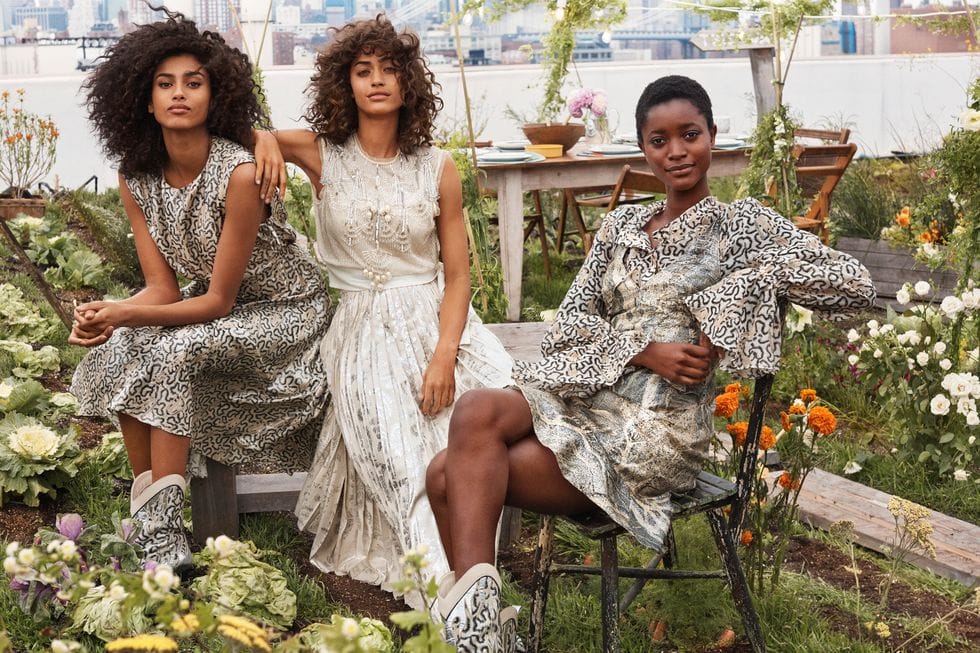Sustainability has never been important to shoppers, nor to the fashion industry. This generation cares about the planet; we might have enjoyed February’s freakishly warm temperatures, but we know that the reasons behind it are dark. We don’t want small animals to be choking on plastics they find in our oceans, nor do we think it’s right that Arctic blocks of ice are now mired with sizeable chunks of polystyrene. We think it’s inexcusable that 300,000 tonnes of unwanted clothes are binned, not recycled, every year.
The rise of ethical and eco-friendly brands is impossible to ignore, but how do we reconcile a love of fashion and clothes with sustainability? A relatively unknown term is currently being bandied around the industry claiming to be the answer – circular fashion. An off-shoot of the circular economy concept – an economic system aimed at minimising waste and making the most of resources – it challenges fashion’s linear production line that ends with clothes being discarded in landfill.
“The future of fashion is circular. It has to be,” says Stella McCartney
“It is a somewhat broader term that ‘sustainable fashion’, as circular fashion combines the principles of both sustainability and circularity,” says Dr Anna Brismar, who coined the term in 2014, and has worked with luxury resale destination Vestiaire Collective to create a an easy-to-use consumer guide to the subject. “Circular fashion relates to not only fashion per se, but also to sportswear, outdoorwear and everydaywear.
“It can be defined as clothes, shoes or accessories that are designed, sourced, produced and provided with the intention to be used and circulated responsibly and effectively in society for as long as possible in their most valuable form, and hereafter return safely to the biosphere when no longer of human use.”
Circular fashion means that every part of the life span of a garment is cyclical – it starts with design of a piece and how much longevity and timelessness it has, then onto the materials and whether or not they are sustainable, before the making of the item – is its production fair and ethical; are workers and animals rights being upheld? Once the piece has become tired, it should be repaired or redesigned, then – rather than being binned – rented, swapped or sold at second-hand. All this means less will be bought and less will left ruining our planet.

Stella McCartney autumn/winter 2019
COURTESY
“The future of fashion is circular. It has to be,” Stella McCartney, sustainability pioneer, told us. “Right now, the equivalent of one dump truck of textiles gets landfilled or burned every second, and by 2025 the clothing waste accumulated between now and then will weigh as much as today’s world population. We can’t ignore it.
“We are always working on new and interesting ways to be more circular as a company,” she added. “It gives us the exciting opportunity to get creative. Currently, the fashion system is linear, so it needs a radical transformation – we need to work together as an industry with huge levels of commitment and innovation and challenge the status quo. We need to evolve from just reducing our impact to making a positive impact, but this can only happen if we all work together.”
“The fashion industry will be forced to come up with new ways of making business”
McCartney isn’t alone in her viewpoint. Bethany Williams, rising design star and recipient of the 2018 Queen Elizabeth II Prize for Design, has been applauded for her rigorous reinvention of the typical production process by turning it into a virtuous cycle. The London-based designer not only uses sustainable materials to create her streetwear collections, but also works with different charities and takes an active role in helping them, rather than just donating money (although a portion of her collections is given away to the various foundations). She gives jobs to those using a respective charity’s services so that they form part of the production line, which bolsters self-worth and self-esteem.
“It’s about trying to make a cycle of production rather than just a production line. It’s a different way of operating,” Williams told us in February this year. Her goal is to set up a UK-based social manufacturing unit. “I’d set it up as a training programme and run it as a social enterprise,” she says. “I’d have different structures, so my brand and my wholesale business, then consultancy, lecturing and teaching and exhibit as an artist.”

Bethany Williams autumn/winter 2019
JEFF SPICER/BFCGETTY IMAGES
Online retailer Yoox agrees that circular fashion is the way forward. “Circularity is one of the many sustainable practices which are possible in fashion and we have recently been exploring it both in our buying,” says Yoox and The Outnet president Paolo Mascio. “We’ve also been exploring the idea within our special projects: the young designers from The Next Green Talents showcase, dedicated to sustainability, each created a unique garment out of prototypes from our private label 8 by Yoox, which was sold on Yooxygen.”
Fast fashion has come under the harshest scrutiny since the shift towards more considered, ethically minded shopping. Our hunger for newness, our last-minute desire for a new dress to wear on a Friday night, comes at a price. Garments are being worn much less and discarded quicker than ever before. So, is it possible for high street giants to engage in circular fashion? Yes, says H&M’s UK & IE Sustainability Manager, Giorgina Waltier, who said that the brand aim to only use sustainably sourced materials by 2030, and to be climate positive by 2040. It’s a bold, well-intentioned goal, but is it realistic?

H&M Conscious spring/summer 2019
COURTESY
In the case of H&M, the company is starting with a focus on recyclable materials and designing with longevity in mind, before considering sustainable production processes when it comes to chemical and water management. The brand was also among the first to offer an in-store consumer recycling scheme, whereby shoppers were offered a £5 voucher in return for handing over clothes to be recycled.
“For the H&M group becoming 100 per cent circular means applying a circular approach to every aspect of our value chain,” said Waltier. “We are also looking at our operations ranging from our stores, offices and logistics centres, through to our transportation to ensure that the way we run these operations enables us to reach our 2040 Climate Positive goal. In short, a circular approach across our entire value chain will enable us to maximise resources and minimise waste thus reducing our negative impact on the environment and society.”

A worker inside an H&M garment factory in Savar, Bangladesh
H&M
Of course, sustainable clothing comes at a higher price, given the ethical materials and production processes required. Anyone with a conscience can see the benefits of shopping sustainably, but not everyone can stretch to higher price points.
“There are lots of ways you can be sustainable without having a big budget,” says McCartney. “I know everyone says it, but the best way is to start by buying investment pieces over fast fashion. You can also reduce your personal impact by giving your old clothes to charity shops, to car-boot sales, to friends and family or by re-selling them, therefore keeping them out of landfill for as long as possible.”
This idea of reselling items isn’t new, yet it’s growing in popularity. Vestiaire Collective attracts 140,000 new members join every month, proving a change in how we now want to shop. The company by nature is part of the circular fashion process, but it still keen to dial up consumer awareness of what the term means with its newly-launched guide available to look at on the site’s home page. The business has also dropped its commission rate to encourage more people to try pre-owned through selling and buying, also resulting in lower prices across the site.

The seven forms of sustainable fashion, as seen in Vestiaire Collective’s online guide
“From a style point of view, it seemed much more personal and fashionable to mix vintage and second-hand pieces with newer items, and from an environmental point of view it provided a responsible solution,” says Vestiaire Collective co-founder and creative director Sophie Hersan. “We wanted to break the rules. Ten years ago, the second-hand market was misunderstood, and the fashion industry didn’t want to recognise it. Today, the market has matured and could take over the demand for affordable and sustainable fashion.”
If our future shopping investments are all made with timelessness and longevity in mind, then the concept of fashion trends, which by their essence are transient, seems problematic. Hersan says not so. “Trends still have a place in the fashion industry and the consumer will always love to be part of it,” she says. “In a similar way, second-hand also follows current trends, but also offers a wider selection of styles and original designs that have been reedited.”
“It’s more personal and fashionable to mix vintage and second-hand with newer items”
There are two long-standing arguments that challenge circular fashion – the first is that it’s just a jumped-up term for recycling and the second is that a decrease in fast fashion will be detrimental for businesses, the idea that if we shop less, sales will slump and jobs will be lost.
The first myth can be debunked quickly – recycling is just one of the many components of the new system; there are a number of criteria that means that a garment is truly circular. As for the second, Dr Anna Brismar says it’s up to the industry to adapt, and it needs to do so fast.
“The fashion industry will be forced to come up with new ways of making business in a world that is naturally limited in time and space and in the availability of arable land, freshwater, minerals and raw oil,” she said. “As the circular economy framework suggests, we need to focus on creating valuable services instead of short-term products. Instead of continuing to support a short-term profit-biased and ownership-focused economy, the fashion industry needs to contribute to building a long-term prosperous and sharing-oriented global economy.”
From: Harper’s BAZAAR UK



